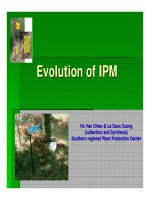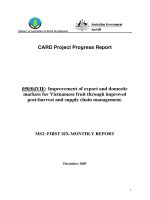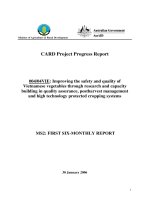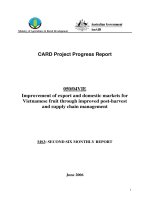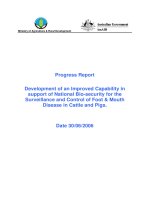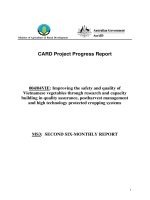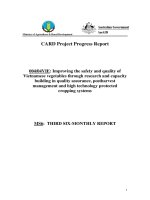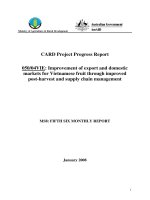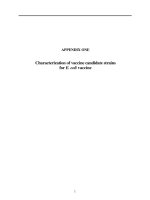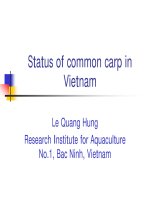Báo cáo nghiên cứu khoa học " IMPROVEMENT OF EXPORT AND DOMESTIC MARKETS FOR VIETNAMESE FRUIT THROUGH IMPROVED POST-HARVEST AND SUPPLY CHAIN MANAGEMENT " potx
Bạn đang xem bản rút gọn của tài liệu. Xem và tải ngay bản đầy đủ của tài liệu tại đây (1.81 MB, 11 trang )
Collaboration for Agriculture and Rur
al Development
(CARD)
Program
44
IMPROVEMENT OF EXPORT AND DOMESTIC MARKETS FOR
VIETNAMESE FRUIT THROUGH IMPROVED POST
-
HARVEST AND
SUPPLY CHAIN MANAGEMENT
Pr
oject title:
Improvement of export and domestic markets for Vietnamese fruit through improved
post
-
harvest and supply chain management
Project code
: CARD 050/04 VIE
Authors:
Nguyen Duy Duc
1
,
R. J. Nissen
3
, Nguyen Minh Chau
2
, Nguyen Ngu
1
, Vu Cong
Khanh
1
,
San Tram Anh
1
, Ngo Van Binh
1
, Tran Thi Kim Oanh
1
Project Implementing organisations:
1
Sub
-
Institute of Agricultural Engineering and Post
-
Harvest Technology (SIAEP)
2
Southern Fruit Research Institute (SOFRI)
3
Queensland Department of Primary Industries
and Fisheries (DPI & F)
1.
Introduction
The fruit industry in Vietnam has a great
potential and plays an important role in
agricultural production. In 2003, Vietnam
exported US$43 million of high value fruit to
high
-
income countries and imported US$14
million of fruit and vegetables. Vietnam is
experiencing difficulties in competing with
other Asian nations in export markets and its
own domestic market, especially with China
and Thailand. Ford et al., (2003), suggested the
competitiveness of Vietnamese
fruit industries
were failing due to poor, unstable product
quality, no quality standards, poor post harvest
technologies and pre
-
harvest practices, lack of
group co
-
operative marketing structures and
little information about supply chains, prices
and cus
tomers needs. This suggests that
Vietnam’s horticultural industries require
substantial development to be globally
competitive.
This project will address constraints by
engaging with key Vietnamese stakeholders
from research institutes (SIAEP and SOFRI)
a
nd local farmers in the mango and pomelo
industries in Southern Vietnam. This project
will take total supply chain network into
account. This project focused on where
significant benefits are to be gained in the pre
-
harvest, post
-
harvest and marketing s
ectors.
This project will alleviate weaknesses in the
supply chain and improve the capacity of
stakeholders involved in pre
-
and post
-
harvest
technologies affecting product quality
consistency. Highly
–
specialised, targeted
training programs, appropriate f
or institutions
and industry stakeholders will be provided in
supply chain management and planning, pre
-
and post
-
harvest technologies.
2.
Research contents and
methodology
2.1
Contents
Cat Hoa Loc mango, Cat Chu mango,
Nam Roi pomelo and Da Xanh pomelo
w
ere selected to conduct research.
A strategic analysis of the mango and
pomelo horticultural industries supply
chains in Vietnam
Mapping and identifying strengths and
weaknesses in existing domestic and
export chains for mango and pomelo,
with particular e
mphasis on determining
consumer preferences and needs, and
feeding results back to farmers
Selection of the key stakeholders and
identification of key pre
-
and post
-
harvest
and cultural constraints
Developing improved export and
domestic supply chains for m
ango and
pomelo
CARD 050/04 VIE
–
Market improvement for Vietnamese fruits
45
Setting up of new supply chains,
improved farmer groups/organisations
for marketing mango and pomelo
Pre and post
-
harvest capacity building of
mango and pomelo farmers.
2.2
Methodology
2.2.1
Manuals developed
2.2.2
Pomelo study
2.2.3
Mango
study
a) Hot water dip treatment
b) Control low temperature in all supply
chains
c) Set up three different value/supply chains.
This was done to demonstrate to the CARD
project participants (farmers to retailers) the
affects each supply chain product fl
ows had on
fruit quality. Three different value/supply
chains were trialled. These were:
•
Traditional supply chain (no change in
technology or supply chain practices)
•
New supply chain (new improved pre
-
and post
-
harvest technologies and hot
water treatment
)
•
Metro Cash and Carry cool supply chain
(New improved pre
-
and post harvest
technologies, hot water treatment and
cool supply chain): For the Metro Cool
Supply Chain fruit were transported from
the pack house in Cai Be, Tien Giang
Province by air conditi
oned van (20
-
25
o
C) to Metro warehouse where the fruit
were temporary placed in the Metro
warehouse cool room at 5
-
10
o
C for 6
-
8
hours. The fruit were then transported to
the supermarkets by a cold truck before
6:00 am of the next day, and displayed
for sal
e at 20
-
25
o
C. Fruits were collected
from the supermarkets and placed in a
cool room (20
o
C) at SIAEP laboratory
until fruit ripened
d) Mango ripening by using ethylene
•
Ripening chamber structure:
The dimension of repining chamber is Length x
Width x Heigh
t = 2800 x 2500 x 2600 mm;
volume of 18,2m
3
with tight
-
close door. There
is one fan at upper ceiling to blow the air inside
the chamber. The floor of ripening chamber is
covered by pallet
•
Operation principle of ripening
chamber;
-
Washing: mango after h
arvest were
transported direct to the laboratory in
the same day. Use clean water 0,2%
hypochlorite sodium to wash mango
before treatment.
-
Mango then was put into plastic tray
in the order and kept a clearance
enough to allow a fan blow ethylene
air
contact equally with the mango
fruit surface.
-
During treatment, the repining door
must be tightly closed to avoid the air
leakage
-
Repining treatment is about 24 hours
and temperature should be maintained
about 28
0
C.
-
Check the content of CO
2
by C
O
2
measurement apparatus. In case its
content is increased over 5%, slowly
open the door chamber within 10
-
15
minutes, then close it again.
Normally open the door once every 12
hours.
-
Use Ethylene 100ppm dosage for
ripening process by using ethylene
r
egulator. The selection of mango
with the similarly weight, size is
advised to get uniform color after
treatment.
-
After repining, open the door
chamber, mango were transferred to
other room to storage at temperature
of 28
0
C within 24 hours before
distr
ibution.
e) Compare the effective of bagging and
non
-
bagging methods
N
.D
Du
c
,
R. J. Nissen,
N.M
Chau, Nguyen Ngu,
V.C
Khanh,
S.T
Anh
,
N.V
Binh
&
T.T
Kim Oanh
46
2.2.4
Pre
-
and post
-
harvest capacity building
of mango and pomelo farmers
Orchard layout and design for mango
and pomelo
Canopy management for pomelo and
mango
Pest and disease control f
or mango and
pomelo
2.2.5
Post
-
harvest capacity building of
mango and pomelo farmers
Development of harvesting poles
Maturity indicators
2.2.6 Training activities
3.
Research results and discussions
3.1
Manuals developed
3.3.1
Developed technical and fie
ld guide pre
-
harvest manuals based on GAP
These manuals were written in Vietnamese
for Vietnamese farmers. Specific subjects
covered were:
Mango Cultivation Handbook
Mango Pest Control Handbook
Mango Disease Control Handbook
Pomelo Cultivation Pest and
Disease Control Handbook.
Manuals covering pre
-
harvest training and
were provided:
Best practice manual for mango
(Mango Information Kit)
Mango and citrus orchard design
Citrus training and pruning manual
Farmer citrus training and pruning
manual
Using che
micals (A chemical
handling and safety manual)
Citrus pest and disease manual
Integrated pest and disease
management (IPDM) system for
pomelo
Mango pest management manual
Improving mango harvest systems
Manuals covering post
-
harvest training
covered:
Opti
mising harvest quality in
mangoes
Mango postharvest manual
Cat Hoa Loc mango quality guide,
Cat Chu mango quality guide,
Nam Roi pomelo quality guide and
Da Xanh pomelo quality guide
Ripening room design
Manuals covering supply/value chain
development and
improvement covered:
Introduction to value supply chains
Developing food value supply
chains
Understanding and monitoring
quality flows
Principles of supply/value chains
Supply/value chian analysis
Developing supply/value chains
Developing strategic plans
Developing action plans
Developing new improved
horticultural supply/value chains
Supply/value chain management of
fresh product quality and food
safety
Understand supply/value chain and
product quality
Processes used to manage fresh
product quality and fo
od safety
Handling and transporting of fresh
produce along a supply chain to
maintain produce quality and
CARD 050/04 VIE
–
Market improvement for Vietnamese fruits
47
deliver safe produce to the
consumer
Marketing and focus group
training
Designing Training Workshops for
mango and pomelo growers in
Vietnam
Socio
-
eco
nomic analysis of mango
and pomelo supply chains in
Vietnam
All manuals were provided to farmers,
collectors, traders, wholesalers, retailers
and exporters who attended the CARD
Project training workshops.
These manuals are one measure to ensure
sustainabi
lity of this project. These
manuals are a way of ensuring long
-
term
project impacts. Manuals are of then used a
source of reference material for SOFRI and
SIAEP staff as well as the local mango and
pomelo farmers. On several of the farm
visits in the Me
kong Delta, farmers would
bring out their manuals, proudly displaying
them and discuss various aspects they have
read or need help with in trying to
implement on their farms.
3.2
Pomelo outcomes
Results from experiments indicated that fruit
treated with C
itra Shine Special Wax had an
increased the shelf life. The increase was about
2 weeks compared to the control and Vacuum
Wrapping treated fruit. The change from green
to yellow was about one week later for the Citra
Shine Special Wax and Vacuum Wrapped
treated fruit compared to the Control treated
fruit. This delay in colour change may have
some effect on the supply chains operating in
the Mekong River Delta in southern Vietnam
by allowing traders, collectors, packing agents
and wholesalers to hold frui
t back from
marketing for about a week.
Vacuum wrapping and moisture condensation
inside the wrapping also played a significant
role in increasing the incidence of disease.
Fruit that are vacuumed wrapped, or have a
special anti
-
transparent applied must
have no
physical damage to the surface of the skin.
Fruit must also be sanitised thoroughly to
eliminate any possible disease infection before
applying postharvest treatments. This is
especially critical for fruit destined for export
due to quarantine r
equirements of importing
countries and developing a reliable trade mark
and reputation for Vietnamese pomelo fruit.
Day
1
7
14
21
28
35
42
49
56
63
70
77
Percentage moisture loss (%)
0
10
20
30
40
Control
Citra Shine Special
Vacuum Wrapping
Days
0
7
14
21
28
35
42
49
56
63
70
77
Taste evaluation (hedonic scale 1-9)
0
1
2
3
4
5
6
7
8
Control
Citra Shine Special Wax
Vacuum Wrapping
Figure 1. Comparison of percentage moisture loss
in Nam Roi P
omelo fruit between control, Citra
Shine Special Wax and Vacuum Wrap treatments
Figure 2. Comparison of the average taste
evaluations for the Control, Citra Shine Special
Wax and Vacuum Wrapping Treatments for Nam
Roi Pomelo
N
.D
Du
c
,
R. J. Nissen,
N.M
Chau, Nguyen Ngu,
V.C
Khanh,
S.T
Anh
,
N.V
Binh
&
T.T
Kim Oanh
48
3.3
Mango outcomes
3.3.1
Hot dip treatment and low
temperature control
Keeping mango fruit cool along the supply
chain in the high humidity and high temperature
conditions in Southern Vietnam significantly
reduces fruit weight loss by 35% to 61% and
extended shelf life by a minimu
m of 4 days.
Combinations of new fibreboard packaging,
hot water dip treatment, plastic crate
packaging and cooling the fruit along the
supply chain significantly reduced disease
infestation by 55% to 93% respectively.
As with most fruit, mangoes are best
ripened at
the wholesale market end of the chain. This
will allow the fruit to travel along the chain in a
hard green state reducing handling damage and
disease development. Mangoes should be
ripened at 18
o
C to 22
o
C as these temperatures
will allow the f
ruit to develop maximum colour,
flavour, texture, taste, and limit the loss of
Vitamins. If these temperatures are maintained
along the supply chain, fruit will still be in a
high quality state and capable of being sold at
the highest market prices.
Days
0
2
4
6
8
10
12
Weight loss (%)
0
2
4
6
8
10
12
14
16
Traditional
New
Metro
Days
0
2
4
6
8
10
12
Percentage (%) of fruit sample affected by disease
0
20
40
60
80
100
Traditional supply chain
New supply chain
Metro cool supply chain
Figure 3. Comparison of the percentage of fruit
weigh loss rate in for the Traditional, New and
Metro Cool Supply Chains
Figure 4. Comparison of the percentage of the fruit
affected b
y disease for the Traditional Supply Chain,
New Supply Chain and the Metro Cool Supply Chain
Development of new cool supply chain
systems, packaging and disease control
methods to extend shelf life of Cat Hoa Loc
mango in Southern Vietnam must be a key
initiative of Government and Institutes to
ensure farmers in the Mekong Delta remain
economically viable.
3.3.2
Mango ripening by using ethylene
Colour: the colour of samples used
ethylene treatment were more
yellow after two days ripening than
controlled
samples, which looked
still green after 4 days storage.
Hardness: the hardness of
controlled samples are still rather
high (3,47
-
4,5 Kg/ cm2) while the
hardness of treated samples are
reduced significantly (1,02 Kg/
cm2).
Degrees Brix: Brix level of ethy
lene
treated samples was increased (from
40
-
80% after 3
-
4 days of treatment)
compared controlled samples.
CARD 050/04 VIE
–
Market improvement for Vietnamese fruits
49
3.3.3
Compare the effective of bagging
and non
-
bagging methods
Bagged fruit were only sprayed once with
pesticides (before bagging), while non
-
bagg
ed
fruit were sprayed a further seven times. This
bagging method provides to consumers a
chemical free, safe product. An 87% reduction
pesticides costs was achieved using fruit
bagging. Table 1 below show 10% to 20%
increase in fruit quality achieved us
ing fruit
bags across all fruit grades. Table 2 below,
show the price received in VND/kg for each
fruit grade
for bagged and non
-
bagged fruit.
Table 1. Comparison of fruit grades, bagged fruit versus non
-
bagged fruit.
Grade
Fruit Bagging (%)
Non
-
Fruit
Bagging (%)
% change
Class 1
60
40
20
Class 2
30
40
10
Class 3
10
20
10
Table 2. Comparison of prices per fruit grade for bagged fruit versus non
-
bagged fruit.
Grade
Fruit Bagging (VND/kg)
Non
-
Fruit Bagging
(VND/kg)
% change
Class 1
35 000
30 000
17
Class 2
25 000
20 000
25
Class 3
10 000
7 000
43
Comparing production costs of fruit bagging on
one Cat Hoa Loc mango tree to one tree that
was not bagged was 231 200 VND vs. 128 000
VND. Comparison of income from one Cat
Hoa Loc mango tree with bag
ged fruit versus
one tree where the fruit were not bagged was
2 573 000 VND vs. 1 824 800 VND. Profit
earned from one Cat Hoa Loc mango tree that
was bagged was 2 341 800 VND compared to a
non
-
bagged tree of Cat Hoa Loc 1 696 800
VND. These studies foun
d that fruit bagging
during the May to August period could
significantly increase incomes by 27%, lifting
socio
-
economic standings.
3.3
Pre
-
harvest capacity building of
mango and pomelo farmers
3.3.1
Orchard layout and design for mango
and pomelo
How to ch
ange from a mixed farming system
orchard to a monoculture blocks of trees (trees
of the same species) planted together within the
total farm orchard received excellent support
from all the groups. This process is in line with
GAP processes in Vietnam. Due
to economics
of doing such redesign of their orchards; it will
take considerable time to implement, as farmers
still have to generate a living from their farms.
Two forms of change were highly acceptable to
the farmers. These are:
gradual tree removal a
nd replacement
planting to an GAP system orchard
design
gradual lopping of large trees (reducing
tree height). The implementation of
canopy management and pruning
practices to increase fruit quality by
allowing:
o
greater light penetration into the
canopy
o
b
etter spray penetration (This will
give greater control of pests and
N
.D
Du
c
,
R. J. Nissen,
N.M
Chau, Nguyen Ngu,
V.C
Khanh,
S.T
Anh
,
N.V
Binh
&
T.T
Kim Oanh
50
diseases thereby reducing effects on
fruit quality and help reduce chemical
costs and application costs)
o
all the crop to be harvested (reducing
pests and disease pressures)
Many pomelo an
d mango farmers are now
planting monoculture blocks of trees to ensure
they can obtain GAP accreditation. For
example, Hoang Gia Company has planted
monoculture blocks of pomelo (about 600 trees)
in the
Binh Minh District.
The Viet Hung
Company has also
planted about 180 hectares
of mango. Mr. Hung an orchardist and director
of the Viet Hung Company has about 15000 m
2
of orchard or 480 mango trees planted at a
spacing of about 6 m x 6m. About 50% of the
area is the mango variety Cat Hoa Loc, 40%
Cat Chu
, and the remaining 10% others
varieties Keow Savoey of Thailand, Kensington
of Australia, and the Taiwanese variety Tuong
-
elephant and Thom of Vietnam. Trees are kept
to a manageable height of less than 4 metres via
canopy management techniques such a pr
uning
and training, tree lopping and top
-
working trees
to new varieties.
3.3.2
Canopy management for pomelo and
mango
Correct canopy management procedures for
pomelo is difficult to achieve in Vietnam due to
farmers having to constantly remove branches
and
limbs due to infestation of Huanglongbing
(greening disease). It is hoped that newly
established orchards trees will be pruned to the
desired tree shape to facilitate the effectiveness
of sprays for pests and diseases and improve
light interception and u
ltimately fruit quality
following GAP for Vietnam.
For mango, the very large, old trees with a
single stem would also prove difficult to prune,
but discussions held at SOFRI with staff and
farmers devised a system for gradual pruning
and training of trees.
Many growers are still
very hesitant or uncertain about the effects of
pruning very old and large mango trees. This is
a cultural factor that has to be addressed in
Vietnam. Other projects conducted by the
Australian team in northern Vietnam have
found
that farmers of stone fruit trees (peach
and plum) and persimmon trees will not prune
their trees because they fear they will die. It
has taken over 6 years and many
demonstrations to convince these farmers that
trees can be lopped, stumped or pruned with
out
dying. Many farmers are not easily convinced
unless they see it demonstrated on their own
orchards.
The demonstration orchard set up by EMU
Vietnam at Cam Rang in Khanh Hoa Province
have been successfully topped and pruned for
several years. Also Mr.
Hung’s orchard at the
My Xuong commune, Cao Lanh district, Dong
Thap Province also demonstrates that mango
trees can be managed by topping, pruning and
training to increase light interception and
improve fruit quality.
3.3.3
Pest and disease control for m
ango and
pomelo
Best practice systems and implementation of
GAP are based on good IPM and IDM
strategies to reduce chemical usage and
contaminants, enabling the producer to provide
a quality assured product for his customers and
finally the consumers.
For
example: The main diseases affecting
mangoes during the postharvest phase, develop
from infections that occur in the field and then
remain latent until the fruit ripen. Disease may
also develop as a result of wound infections that
occur during the harvest
ing and postharvest
handling of the fruit. Applying chemicals at
late fruit development stages in field or during
the postharvest phase increase the risks of
chemical contamination and may void quality
assurance standards. Therefore, correctly
identifyin
g the disease and the chemical that
will control the disease and correct application
(rate and timing) early in the field is the safest,
avoiding contamination, health and safety
issues and voiding quality assurance standards.
Anthracnose is a fungus that
affects most parts
of the mango tree. It grows on leaves, young
shoots, flowers and fruit. The fungus spreads
CARD 050/04 VIE
–
Market improvement for Vietnamese fruits
51
from spores that are produced on dead twigs,
branches and leaves. These spores are spread
by water splash onto new growth. Infection on
the fl
owers and young fruit can cause severe
flower and fruit drop, but on larger fruit the
infection can lie dormant until the fruit starts to
ripen, when the fungus develops into large
black areas. Infection can be controlled by
protectant sprays during flowe
ring. This limits
the control measures that may have to be taken
during the postharvest phase. This GAP
practice also significantly reduces production
costs.
An example for citrus is the monitoring of pests
and diseases. By correctly designing and
openi
ng up orchards, not planting too close,
increasing light interception and carrying out
canopy management will significantly assist in
the management of diseases as phytophthora
and huanglongbing (citrus greening disease).
Opening up the orchard provides l
ess
favourable conditions for the psyllids which
spread the disease. Discussions with
huanglongbing disease specialists indicated that
inter
-
planting with guava may reduce the
incidence of huanglongbing disease and
prolong the tree life by disrupting the
psyllids
movements due to volatiles released from the
guava trees.
Where pomelo fruit hang together on the tree
and mature, they usually develop disease where
they touch each other. It was proposed to
farmers, where fruit hang in doubles that one
fruit be
removed early to avoid diseases
building up on the fruit. This process will
increase the number of marketable fruit per tree
thereby increasing yield and farm gate returns.
3.4
Postharvest capacity building for
mango and pomelo farmers
After training, Ma
ngo groups have initiated
new harvesting procedures and process to
ensure quality standards and GAP are adhered
to. For example:
o
Mango fruit are harvested in the morning,
but on occasions when rain or other crop
management factors intervene, fruit may
be
harvested at any time of day.
o
Harvesting poles are used to harvest the
fruit from the ground and from high up in
the tree canopy.
o
All fruit are harvested with long stems
(up to 10 cm if possible) and placed into
paper
-
lined baskets.
o
Paper is also placed
between each layer
of fruit in the baskets to protect fruit from
sap burn or rub marks.
o
Harvested fruit stems are usually cut to 2
cm in length and placed on wire trays
with stem down to allow sap to ooze.
o
Fruit are left on the ground for
approximately 2 h
ours then wrapped in
newspaper and placed into 20 kg baskets.
o
Mango branches, paper or banana
leaves are used to cover fruit in these
baskets whilst in the field.
3.4.1
Development of harvesting poles
Harvesting poles have scissors and are used to
cut fr
uit from the branches and a soft cloth bag
attached to catch the fruit (Figure 5). All fruit
are now harvested with long stem 15 to 20 cm
in length if possible. This system replaces the
old harvesting pole with cutter blade (Figure 6)
with a net to catch
fruit. Another earlier
method used was a picking pole with a looped
wire to pull or snap the fruit from tree branches
(Figure 7). Fruit were caught in a cloth bag
suspended underneath the picking pole. The
last two systems were reported to increase the
incidence of sap burn, downgrading fruit from
class 1 to class 3. Growers reported that net
bags are too rough and damage the skin of the
fruit. Soft bags also have problems, sap
adheres to the material, builds up, and causes
sap burn and abrasion damage
on the skin of the
fruit.
Collaboration for Agriculture and Rur
al Development
(CARD)
Program
52
Figure 5. New mango harvesting system using
scissors to cut the fruit from the tree.
Figure 6. Old system that uses blades to cut mango fruit
from trees whilst catching fruit in a net.
Figure 7. Old system where fr
uit is pulled from tree
branches and caught in a cloth bag suspended
underneath.
Figure 8. New mango harvesting systems, cutting fruit
from trees branches using scissors and cloth bag to catch
fruit.
3.4.2
Maturity indicators
Fruit are harvested when:
length of time from flowering to
harvest maturity, 84 days
fruit change from a dark green colour to
light green colour
fruit shape is full
shoulders of the fruit are full and fruit
beak has filled out
no visible line down the centre of the
fruit.
3.5
Trai
ning activities
Sixty three workshops were conducted during
this project, to train 677 farmers and 124
collectors and wholesalers (not included other
participants in supply chains). In
-
field,
participatory action learning workshops
provided a better under
standing of how
improvements to the mango and pomelo
supply/value chains operating in Southern
Vietnam. Forty four manuals and workbooks
were developed and used in the CARD Project
and 24 reports which10 papers published in
international journals and wor
kshops were
produced covering.
4.
Conclusions
A strategic analysis of the mango and pomelo
supply/value chains operating in southern
Vietnam was completed by SIAEP and SOFRI
staff, farmers, collectors, traders, wholesalers,
exporters and retailers.
This
strategic analysis process, in manual form
was provided to both SIAEP and SOFRI staff to
use for development of future fruit and
vegetable supply/value chains. Strategic plans
workshops were also held in villages with
CARD 050/04 VIE
–
Market improvement for Vietnamese fruits
53
mango and pomelo growers and with co
llectors
to discuss supply chain maps, the SWOT
analysis and strategic plans developed at
previous workshops and to adjust and obtain
input from a wider cross section of
farmer/growers. Action plans were also
developed based on the agreed vision, goals an
d
future direction for both the mango and pomelo
CARD project participants.
New supply chains were developed with Metro
Cash & Carry and various high value retailers
in TP Ho Chi Minh City for mango and
pomelo. This project was not involved in the
busin
ess to business negotiations but assisted in
developing good agricultural practices (GAP)
and quality assurance systems.
In 2008, the Cat Hoa Loc Mango Group sold
about 700kg to 1 tonne of Cat Hoa Loc grade 1
fruit to Metro Cash & Carry Vietnam Ltd., as a
trial shipment using a new developed
supply/value chain. This fruit sold from 55,000
to 75,000 VND/kg. This is about double to
triple the normal price. At the end of the
CARD Project, a contract was signed with
Metro Cash & Carry to supply 5 tonne of f
ruit.
They also supply about 70 tonnes of mango in
2009 and 100 tonnes of mango in 2010 for
processor in Ho Chi Minh city to Japan market.
They use the ripening procedure developed by
this project and their main products is frozen
fresh
-
cut to supply Japa
nese company.
References
1.
Nguy
ễ
n Duy Đ
ứ
c, R. J. Nissen , Nguy
ễ
n
Minh Châu and et. Final report of 050/04
VIE Project, period from 2006
-
2009.
2.
Nguyen Huu Hinh. 2007. Flooding in
Mekong River Delta, Viet Nam. Human
Development Report 2007/2008, Fight
ing
climate change: Human solidarity in a
divided world. Human Development Report
Office, Occasional Paper. Available:
-
/>07
-
2008/papers/Nguyen_Huu%20Ninh.pdf
Date 19/03/2009.
3.
Mekong Delta Economic Cooperation
(MD
EC). 2008. The Mekong delta News,
Suggesting Solutions on developing skilled
workforce in the Mekong Delta. Available :
/>lGbn5WZ9ATb. Date December 2008.l
4.
Oxfam. 2008. Viet Nam, Climate Change,
Adaptation and Poor P
eople. Report for
Oxfam October 2008. Available:
/>nsf/FilesByRWDocUnidFilename/COT
-
7LKJ38
-
full_report.pdf/$File/full_report.pdf. Date:
19/03/2009.
5.
Population Reference Bureau (PRB). 2009.
Vietnam Statistics. Avai
lable:
-
/>Countries/Vietnam.aspx. Date;
-
12/03/2009
6.
Robert L. S; Bernhard B. 2000. Fruit and
Vegetable Quality. CRC Press.
7.
Ross C. B; Suresh D. P; Timothy D. P,
2004. Preharvest and Postharvest Food
Safety: Contemporary Issues and Fut
ure
Direction. Blackwell Publishing.
8.
Thompson, A.K; Fruit and Vegetables:
Harvesting, Handling and Storage, 2003.
Blackwell Publishing.
9.
Van Mele, P, Nguyen Thi Thu Cuc, and
Van Huis, A. 2001. Farmers’ knowledge,
perceptions and practices in mango pest
m
anagement in the Mekong Delta,
Vietnam. International Journal of Pest
Management, 2001, 47(1) 7± 16.
10.
United Nations Family planning
Association (UNFPA). 2009. Vietnam
Population 2007. Available:
-
/>ien%20dong%20dan
%20so_UNFPA_eng.p
df. Date:
-
12/03/2009.
11.
United Nations Family planning
Association (UNFPA). 2007. Internal
Migration in Vietnam, The Current
Situation. UNFPA Hanoi. June 2007.
Available:
-
/documents/2008/Internal%20Migration_C
u
rrent%20situation_e.pdf. Date:
-
12/03/2009
N
.D
Du
c
,
R. J. Nissen,
N.M
Chau, Nguyen Ngu,
V.C
Khanh,
S.T
Anh
,
N.V
Binh
&
T.T
Kim Oanh
54
12.
U.S. Department of State. 2009.
Background Note: Vietnam. US Bureau of
East Asian and Pacific Affairs. March
2009. Under Secretary for Public
Diplomacy and Public Affairs. Bureau of
Public Affairs. Electron
ic Publication
Office. Available:
-
/>Date:
-
16/03/2009.
13.
Van Mele, P, Nguyen Thi Thu Cuc, and
Van Huis, A. 2001. Farmers’ knowledge,
perceptions and practices in mango pest
management in the Mekong Delta,
Vietnam
. International Journal of Pest
Management, 2001, 47(1) 7± 16.
